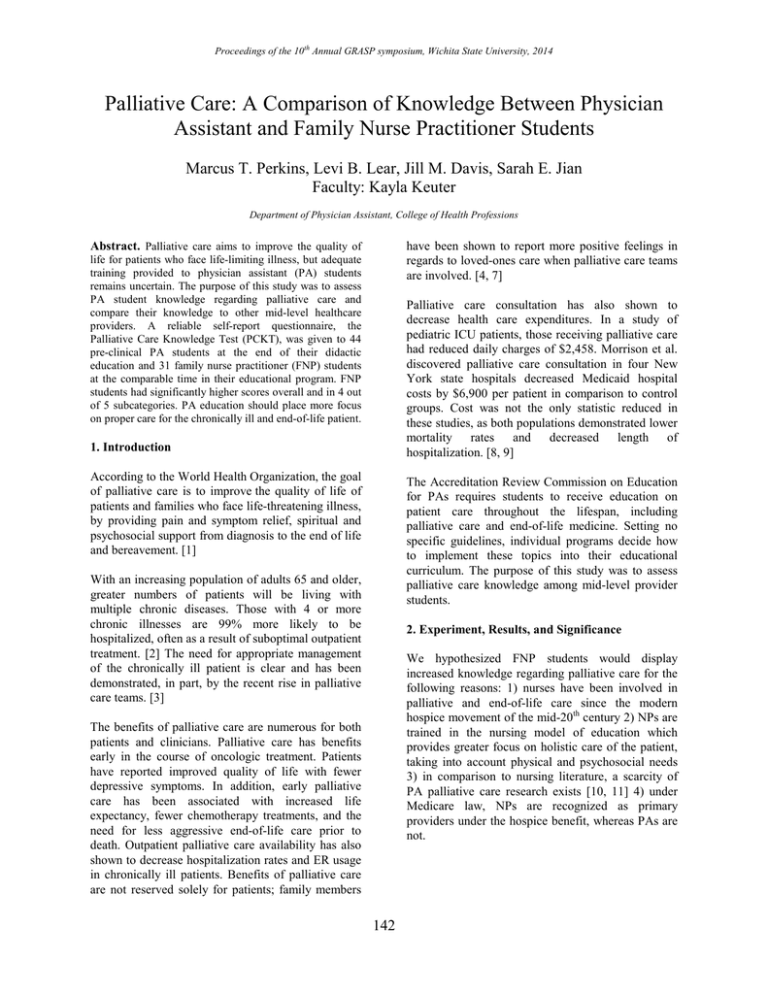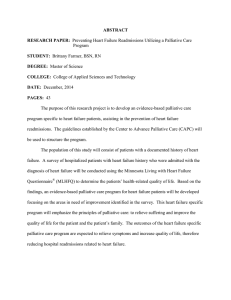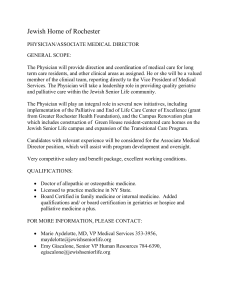Palliative Care: A Comparison of Knowledge Between Physician
advertisement

Proceedings of the 10th Annual GRASP symposium, Wichita State University, 2014 Palliative Care: A Comparison of Knowledge Between Physician Assistant and Family Nurse Practitioner Students Marcus T. Perkins, Levi B. Lear, Jill M. Davis, Sarah E. Jian Faculty: Kayla Keuter Department of Physician Assistant, College of Health Professions have been shown to report more positive feelings in regards to loved-ones care when palliative care teams are involved. [4, 7] Abstract. Palliative care aims to improve the quality of life for patients who face life-limiting illness, but adequate training provided to physician assistant (PA) students remains uncertain. The purpose of this study was to assess PA student knowledge regarding palliative care and compare their knowledge to other mid-level healthcare providers. A reliable self-report questionnaire, the Palliative Care Knowledge Test (PCKT), was given to 44 pre-clinical PA students at the end of their didactic education and 31 family nurse practitioner (FNP) students at the comparable time in their educational program. FNP students had significantly higher scores overall and in 4 out of 5 subcategories. PA education should place more focus on proper care for the chronically ill and end-of-life patient. Palliative care consultation has also shown to decrease health care expenditures. In a study of pediatric ICU patients, those receiving palliative care had reduced daily charges of $2,458. Morrison et al. discovered palliative care consultation in four New York state hospitals decreased Medicaid hospital costs by $6,900 per patient in comparison to control groups. Cost was not the only statistic reduced in these studies, as both populations demonstrated lower mortality rates and decreased length of hospitalization. [8, 9] 1. Introduction According to the World Health Organization, the goal of palliative care is to improve the quality of life of patients and families who face life-threatening illness, by providing pain and symptom relief, spiritual and psychosocial support from diagnosis to the end of life and bereavement. [1] The Accreditation Review Commission on Education for PAs requires students to receive education on patient care throughout the lifespan, including palliative care and end-of-life medicine. Setting no specific guidelines, individual programs decide how to implement these topics into their educational curriculum. The purpose of this study was to assess palliative care knowledge among mid-level provider students. With an increasing population of adults 65 and older, greater numbers of patients will be living with multiple chronic diseases. Those with 4 or more chronic illnesses are 99% more likely to be hospitalized, often as a result of suboptimal outpatient treatment. [2] The need for appropriate management of the chronically ill patient is clear and has been demonstrated, in part, by the recent rise in palliative care teams. [3] 2. Experiment, Results, and Significance We hypothesized FNP students would display increased knowledge regarding palliative care for the following reasons: 1) nurses have been involved in palliative and end-of-life care since the modern hospice movement of the mid-20th century 2) NPs are trained in the nursing model of education which provides greater focus on holistic care of the patient, taking into account physical and psychosocial needs 3) in comparison to nursing literature, a scarcity of PA palliative care research exists [10, 11] 4) under Medicare law, NPs are recognized as primary providers under the hospice benefit, whereas PAs are not. The benefits of palliative care are numerous for both patients and clinicians. Palliative care has benefits early in the course of oncologic treatment. Patients have reported improved quality of life with fewer depressive symptoms. In addition, early palliative care has been associated with increased life expectancy, fewer chemotherapy treatments, and the need for less aggressive end-of-life care prior to death. Outpatient palliative care availability has also shown to decrease hospitalization rates and ER usage in chronically ill patients. Benefits of palliative care are not reserved solely for patients; family members 142 Proceedings of the 10th Annual GRASP symposium, Wichita State University, 2014 Table 1 Palliative Care Knowledge Test Total and Subcategorical Scores Physician Assistant Nurse Practitioner Number Of Students Surveyed 44 31 Total Score (% correct) 46.14 59.8 Philosophy Score (% correct) 79.55 95.16 Pain Management Score (% correct) 47.35 56.45 Dyspnea Score (% correct) 35.23 62.9 Psychiatric Score (% correct) 35.23 41.13 Gastrointestinal Score (% correct) 49.43 62.9 Study Design Survey Tool The PCKT is a reliable and valid 20-question selfreport questionnaire developed as a tool to assess knowledge regarding 5 crucial areas of palliative care: philosophy, pain, dyspnea, psychiatric, and gastrointestinal. Responses include “correct,” “incorrect,” or “unsure.” [1, 2] p <.001 0.009 0.043 <.001 0.207 0.016 3. Conclusions Despite academic requirements regarding palliative care and end-of-life education, PA students lack clinical knowledge on these topics. Specific categories that PA education should further focus on include: philosophy of palliative care and management of dyspnea, pain, and gastrointestinal symptoms in the chronically ill and dying patient. Further studies should include larger sample sizes from multiple educational programs to better assess palliative care knowledge amongst students. Population Participants included 44 PA students in their final didactic semester prior to beginning clinical rotations and 31 FNP students beginning their 3rd year of training. PA students received two one-hour lectures regarding palliative care given by a clinical psychologist and pain management physician. FNP education included a semester of hospice and home health nursing during registered nurse (RN) training as well as a 3-hour lecture regarding hospice during FNP training. 4. Acknowledgements We would like to acknowledge Professor Patricia Dwyer, MSN, APRN, FNP-C, Ashley M. Hervey, MEd, Research Associate for KU School of Medicine in the Preventive Medicine and Public Health Department, and the Wichita State University Family Nurse Practitioner Program for their assistance and participation in this study. Statistical Analyses Descriptive statistics were summarized using frequencies and percentages for categorical variables and means with standard deviations for continuous variables. Differences in continuous variables were evaluated by the Mann-Whitney test and categorically by chi-square statistics. 5. References Results [1] Sepulveda C, Marlin A, Yoshida T, Ullrich A. Palliative Care: The World Health Organization’s Global Perspective. Journal of Pain and Symptom Management 2002;24(2):91-96. [2] Wolff JL, Starfield B, Anderson G. Prevalence, expenditures, and complications of multiple chronic conditions in the elderly. Archives of Internal Medicine 2002;162(20):2269-2276. [3] Growth of palliative care in U.S. hospitals 2012 snapshot, Center to Advance Palliative Care web site; http://www.capc.org/capc-growthanalysis-snapshot-2011.pdf. 2012. Accessed February 22, 2014. [4] Temel JS, Greer JA, Muzikansky A, et al. Early palliative care for patients with metastatic non-small-cell lung cancer. New England Journal of Medicine 2010;363(8):733-742. [5] Higginson IJ, Finlay IG, Goodsin DM, et al. Is there evidence that palliative care teams alter end-of-life experiences of patients and their caregivers? Journal of Pain and Symptom Management 2003;25(2): 150-168. [6] Barrett M, Wheatland B, Haselby P et al. Palliative respite services using nursing staff reduces hospitalization of patients and improves acceptance among carers. International Journal of Palliative Nursing 2009;15(8):385-395. [7] Owens D, Eby K, Burson S, et al. Primary palliative care clinic pilot project demonstrates benefits of a nurse practitioner-directed clinic providing primary and palliative care. Journal of the American Academy of Nurse Practitioners 2012;24(1):52-58. Overall scores were higher among FNP students than PA students. FNP students also displayed significantly higher scores in the philosophy, pain management, dyspnea, and gastrointestinal subcategories. Significance An aging population has lead to an increasing number of people suffering from multiple chronic illnesses. Enhancing education to PA students may better provide patients and their families the benefits of palliative care. These strategies may also aid in expanding PA roles and reimbursement in palliative care and hospice medicine. 143 Proceedings of the 10th Annual GRASP symposium, Wichita State University, 2014 [8] Keele L, Keenan HT, Sheetz J. Differences in characteristics of dying children who receive and do not receive palliative care. Pediatrics 2013;132(1):72-78. [9] Morrison RS, Dietrich J, Ladwig S et al. Palliative care consultation teams cut hospital costs for Medicaid beneficiaries. Health Affairs 2011;30(3):454-463. [10] Berge NE, Prerost FJ, Foltz PF. Attitudes of physician assistant students to hospice care and assisted suicide. Perspective on Physician Assistant Education 2001;12(3):177-181. [11] Lanning LC, Dadig BA. A strategy for incorporating palliative care and end-of-life instruction into physician assistant education. Journal of Physician Assistant Education 2010;21(4):41-46. [12] Nakazawa Y, Miyashita M, Morita T, et al. The palliative care knowledge test: reliability and validity of an instrument to measure palliative care knowledge among health professionals. Palliative Medicine Journal 2009; 23(8):754-66. 144






